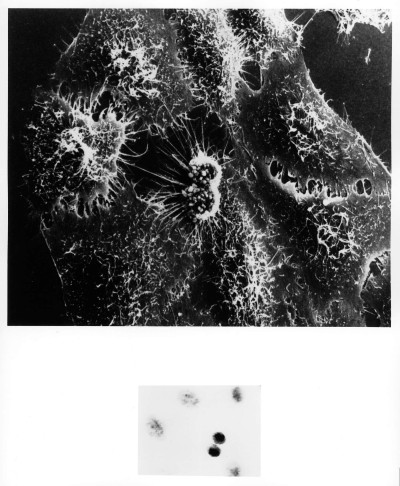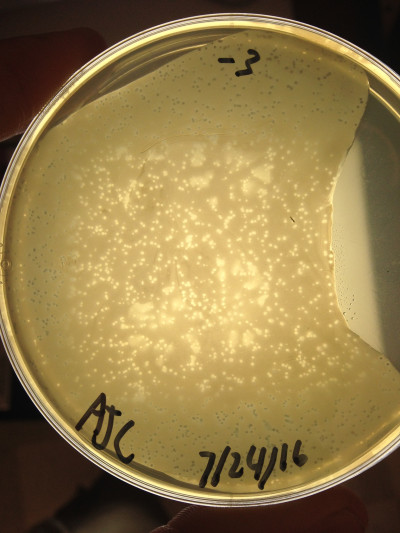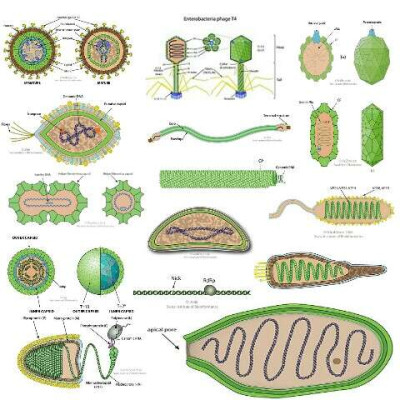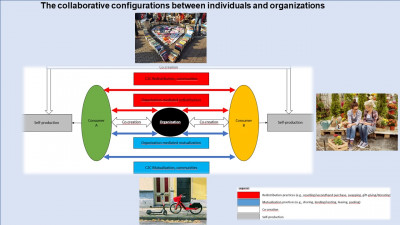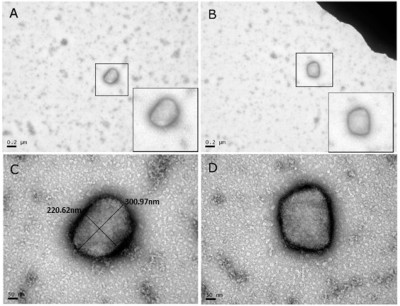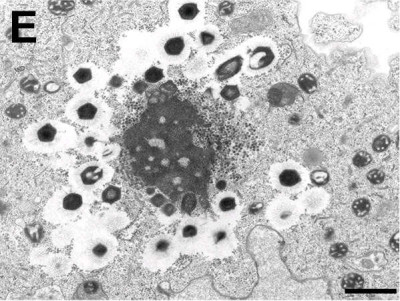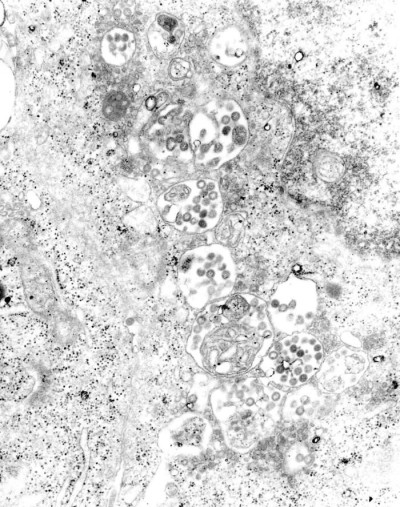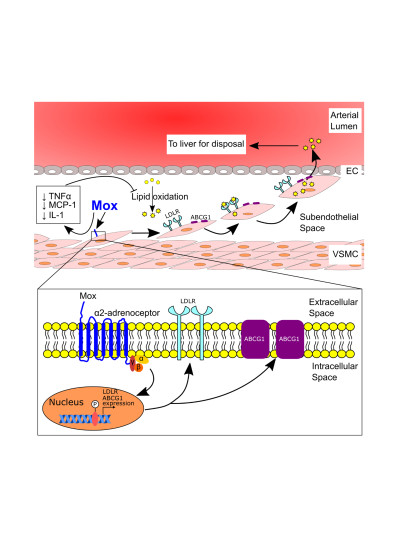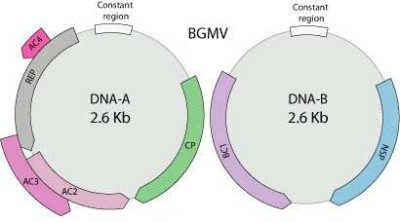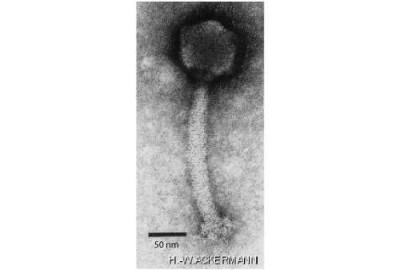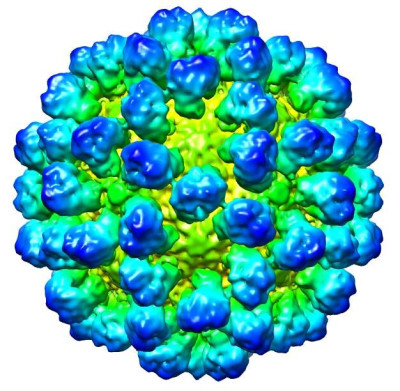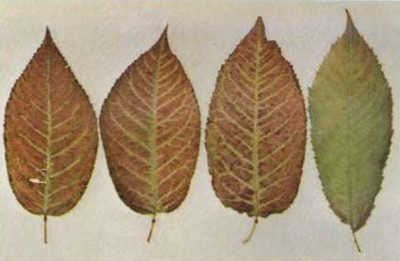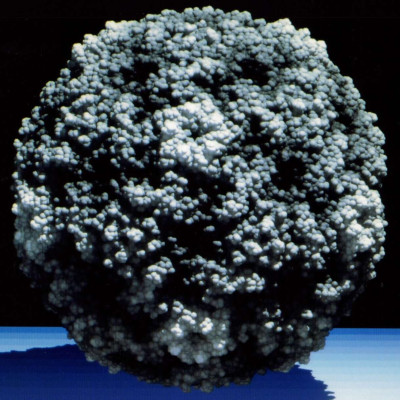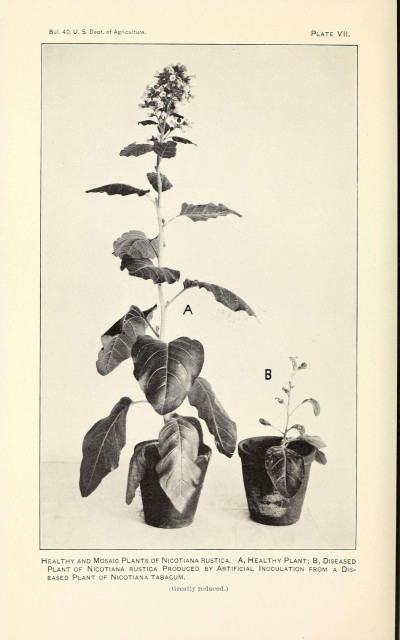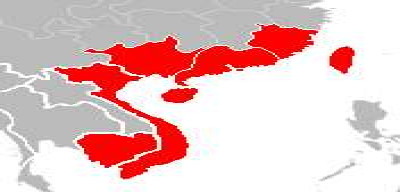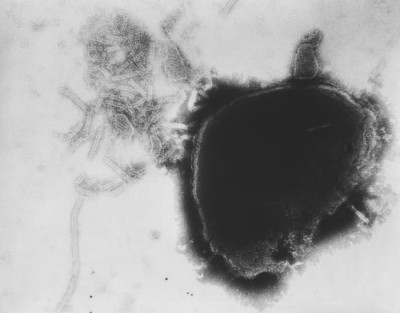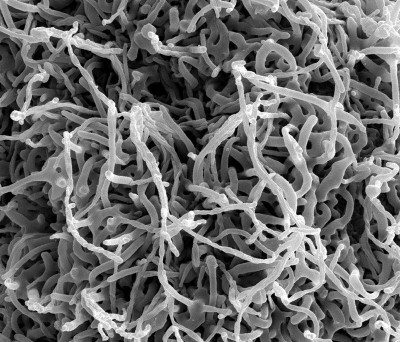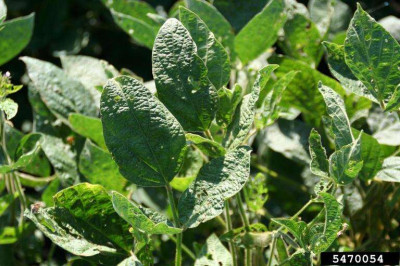A scanning electron micrograph of cultured HeLa cells originally derived many years ago from a woman's cancerous cervical tissue. A light micrograph (x130) of the same cells (inset) reveals rounded double cells in the center in the process of dividing. This HeLa cell (named after patient Henrietta Lacks) has been infected with adenovirus. After 4-1/2 hours the HeLa cell's surface becomes rough. The multiple surface blebs on this cell characteristic for a certain stage of cell division that both normal and cancer cells go through. Research with the SEM has established the extraordinarily responsive nature of cell surface form. This instrument records, in pictures, specific cell reactions to various changes in the cells environment and maps the distribution of surface binding sites for biologically important molecules such as hormone, antigens, and pharmacologic agents.
Timothy Triche, National Cancer Institute, Wikimedia Commons
08 Feb 2024
Arthrobacter is primarily a genus of soil bacteria characterized by a distinctive growth cycle involving both rod and coccus shapes. Initially, irregular rods predominate in young cultures, but as they reach the stationary phase, they transition into coccoid cells.
iNaturalist, Andrew Conboy
01 Mar 2024
Collaborative configurations between consumers and organizations can be of four types:
(1) Redistribution practices (i.e., reselling/secondhand purchase, swapping, donating/gift-giving) either directly (i.e., consumer-to-consumer) or indirectly via organizations (e.g., an individual trades in used clothing to a secondhand shop which then resells it to other individuals)
(2) Mutualization practices (i.e., lending/renting, leasing, pooling, sharing) either directly (i.e, C2C) or indirectly via organizations (e.g., an individual uses a rede-hailing platform to benefit from another individual's car transportation services)
(3) Co-creation practices either directly (e.g., individuals engaging mutually in gardening) or with organizations (e.g., individuals participating to an open innovation initiative launched by an established chain of coffee shops to generate new coffee flavors)
(4) Self-production involves individuals engaging in productive and creative work (e.g., gardening, do-it-yourself)
22 Jan 2024
Transmission electron microscopy (TEM) images of viral particles of camelpox virus (CMLV) extracted from lesions taken from four individual camels and negatively stained with 1% Phosphotungstic acid (PTA). Note that the morphology and dimensions of the virus particles corresponds with the morphology and dimensions of the Orthopoxvirus (OPV) family. [1]
Oran Erster, Sharon Melamed, Nir Paran, Shay Weiss, Yevgeny Khinich, Boris Gelman, Aharon Solomony, and Orly Laskar-Levy
31 Jan 2024
Transmission electron micrograph showing virus factories in amoeba co-infected with Zamilon virophage and the Mimiviridae, Mont1 (scale bar 0.1 µm). [1]
Morgan Gaia, Samia Benamar, Mondher Boughalmi, Isabelle Pagnier, Olivier Croce, Philippe Colson, Didier Raoult and Bernard La Scola., Wikimedia Commons
07 Feb 2024
This transmission electron micrograph (TEM) depicted a highly magnified view of a tissue that had been infected with Rift Valley fever (RVF) virus. RVF virus is a member of the genus Phlebovirus in the family Bunyaviridae and was first reported in livestock in Kenya around 1900. It is found to be an acute, fever-causing viral disease that affects domestic animals (such as cattle, buffalo, sheep, goats, and camels) and humans. RVF is most commonly associated with mosquito-borne epidemics during years of unusually heavy rainfall.
Public Health Image Library
23 Feb 2024
Moxonidine decreases the expression of inflammatory genes (e.g., TNF-α), which inhibit the oxidation of LDL. Moxonidine enhances VSMC migration. These VSMCs then migrate to a location that could facilitate both oxidised LDL uptake via the LDL receptor and its efflux back to circulation via the ABCG1 transporter for detoxification and elimination by the liver. Thus, moxonidine may inhibit atherosclerosis by inhibiting inflammation and promoting oxidised LDL clearance from the atherosclerotic plaque. ABCG1, ATP binding cassette subfamily G member 1; EC, endothelial cell; IL, interleukin; LDL, low-density lipoprotein; LDLR, low-density lipoprotein receptor; MCP-1, monocyte chemoattractant protein-1; Mox, moxonidine; TNF-α, tumour necrosis factor-α; VSMC, vascular smooth muscle cell. [1]
29 Feb 2024
Genome map of Bean golden mosaic virus (BGMV), genus Begomovirus.
ViralZone, SIB Swiss Institute of Bioinformatics, Wikimedia Commons
01 Mar 2024
Electron microscopic image of a virion of the genus Twortvirus (aka Twortlikevirus).
ViralZone, SIB Swiss Institute of Bioinformatics, Wikimedia Commons
01 Mar 2024
Rabbit Hemorrhagic Disease Virus (RHDV) capsid EMD-1933.
A2-33, Wikimedia Commons
01 Mar 2024
Star cherry leaves affected by little cherry disease, showing red coloration in the areas between the main veins and the retention of green along the midrib and larger veins. Leaf on right is normal.
Maurice F. Welsh and Philip W. Cheney, Wikimedia Commons
08 Mar 2024
Graphical 3D representation of an Enterovirus E virion.
Wikimedia Commons, Captain Janeway and Captain Kirk
11 Mar 2024
Healthy (A) and mosaic (B) plants of Nicotiana rustica.[1]
Wikimedia Commons
14 Mar 2024
Cryo-EM reconstruction of the CroV virion and capsomer arrangements of other giant icosahedral viruses. (A) Reconstruction of the CroV capsid. The isosurface of the map was colored by pentasymmetrons (purple) and trisymmetrons (blue, red, green, cyan and orange). One of the 30 edges of the icosahedron is marked by a cyan line. Two surface areas (a,b) are magnified and selected capsomers are labeled by yellow triangles to show their orientations. (B–E) Isolated icosahedral faces of CroV, PBCV-1, CIV and PpV01 capsids are shown schematically. Their T-numbers, asymmetric unit capsomer numbers, and trisymmetron capsomer numbers are listed. 5-fold, 3-fold, and 2-fold symbols are indicated in red and ASUs are outlined in blue. [1]
Xiao, C., Fischer, M.G., Bolotaulo, D.M., Ulloa-Rondeau, N., Avila, G.A., and Suttle, C.A
18 Apr 2024
Distribution of Longan witches broom-associated virus.
Wikimedia Commons, YpnaC
23 Apr 2024
This transmission electron micrograph (TEM) revealed the presence of numerous paramyxovirus virions, which in this instance, were responsible for a case of the mumps. Paramyxoviruses are members of the family, Paramyxoviridae, and those that cause mumps in humans belong to the genus, Rubulavirus. The virus itself can present itself in a number of morphologic shapes, including spherical, and stand-like, or filamentous, ranging from 150nm to 200nm in diameter, and 1000nm to 10000nm in length. At its core lies a non-segmented, negative-sense RNA genome.
Public Health Image Library
17 Jan 2024
Colorized transmission electron micrograph of monkeypox particles (pink) found within an infected cell (green), cultured in the laboratory. Image captured at the NIAID Integrated Research Facility (IRF) in Fort Detrick, Maryland.
NIAID
31 Jan 2024
Scanning electron micrograph of filamentous Ebola virus particles replicating from an infected VERO E6 cell (50,000x magnification).
Wikimedia Commons, NIAID
02 Feb 2024
Symptoms of soybean mosaic virus (Potyvirus SMV).
Wikimedia Commons, Daren Mueller
14 Mar 2024
 Encyclopedia
Encyclopedia
